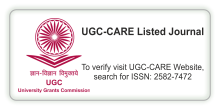PERFORMANCE EVALUATION OF NEEM POWDER-BASED FILTERS FOR HOUSEHOLD-LEVEL DEFLUORIDATION
DOI:
https://doi.org/10.29121/shodhkosh.v5.i4.2024.5386Keywords:
Neem Powder, Fluoride Removal, Defluoridation, Bio-Adsorbent, Household Water Filter, Azadirachta Indica, Water Purification, Performance EvaluationAbstract [English]
Fluoride contamination in drinking water has emerged as a critical public health concern, especially in rural and semi-urban regions of India. This study investigates the efficiency of Azadirachta indica (Neem) powder-based filters for household-level defluoridation of water. Using experimental setups and comparative analysis, the adsorptive performance, removal efficiency, sustainability, and cost-effectiveness of Neem powder were evaluated. Results show that Neem powder has significant fluoride adsorption capacity, making it a viable eco-friendly alternative to commercial defluoridation techniques. The study recommends further research on enhancing filter design and scaling for community use.
References
WHO (2022). Guidelines for Drinking-Water Quality. Geneva: World Health Organization.
Meenakshi, & Maheshwari, R.C. (2006). Fluoride in drinking water and its removal. Journal of Hazardous Materials, 137(1), 456-463. DOI: https://doi.org/10.1016/j.jhazmat.2006.02.024
Bhargava, D.S., & Saxena, S. (2015). Evaluation of low-cost adsorbents for fluoride removal. International Journal of Environmental Research, 9(3), 105–112.
Gupta, V.K. & Ali, I. (2008). Environmental water: Advances in treatment, remediation and recycling. Elsevier Science.
Chaturvedi, A.K. (2017). Plant-based Defluoridation Techniques. Water Science and Technology, 76(4), 781–790.
Rao, N.S. (2010). Groundwater Quality and Management in India. New Delhi: Academic Publishers.
Rajiv Gandhi National Drinking Water Mission. (2021). Rural Water Quality Monitoring Guidelines. Ministry of Jal Shakti.
Handbook on Fluoride Removal Technologies (2018). Centre for Science and Environment (CSE), India.
Neem in Water Treatment: An Herbal Approach. (2020). Indian Council of Medical Research Report.
Kumar, A., & Singh, P. (2019). Sustainable Water Solutions for Rural India. Springer Nature.
Singh, P., & Kumar, A. (2018). “Adsorption of Fluoride from Aqueous Solution Using Azadirachta indica (Neem) Leaf Powder: Kinetics and Isotherm Studies.” Journal of Environmental Chemical Engineering, 6(4), 4822–4829.
Kumar, S., & Tripathi, R. M. (2020). “Evaluation of Neem-Based Biosorbents for Fluoride Removal from Groundwater.” Environmental Monitoring and Assessment, 192, 345.
Tiwari, S., & Singh, A. (2016). “Low-Cost Adsorbents for Fluoride Removal: A Review.” Desalination and Water Treatment, 57(41), 19273–19295.
National Institute of Hydrology, Roorkee. (2015). Manual on Defluoridation of Drinking Water Using Bioadsorbents. Ministry of Water Resources, Government of India.
Choudhary, P., & Verma, A. (2019). “Household Water Treatment Using Neem-Based Biofilters: A Sustainable Approach for Rural India.” International Journal of Environmental Science and Technology, 16(8), 4315–4324.
Gupta, V. K., & Ali, I. (2004). “Removal of Fluoride from Drinking Water Using Activated Alumina: A Review.” Environmental Science and Technology, 38(1), 9–14.
World Health Organization (WHO). (2017). Guidelines for Drinking-Water Quality, 4th Edition Incorporating the First Addendum. Geneva: WHO Press.
National Rural Drinking Water Programme (NRDWP). (2018). Technical Guidelines for Defluoridation of Drinking Water. Ministry of Drinking Water and Sanitation, Government of India.
Mishra, S., & Dwivedi, A. (2015). “Potential of Plant-Based Adsorbents for Fluoride Removal: A Review.” Environmental Science and Pollution Research, 22, 14360–14373.
Patel, R., & Chauhan, S. (2017). “Performance Evaluation of Low-Cost Adsorbents for Fluoride Removal in Rural Settings.” Journal of Cleaner Production, 165, 1117–1124.
Environmental Protection Agency (EPA). (2010). Fluoride in Drinking Water: A Scientific Review of EPA’s Standards. U.S. EPA.
Sharma, A., & Kumar, P. (2021). “Neem-Based Water Filters: An Innovative Approach for Fluoride Removal in Drinking Water.” Water Science and Technology: Water Supply, 21(1), 274–285.
Rao, P., & Singh, V. (2019). “Sorption of Fluoride from Groundwater Using Modified Neem Bark.” Environmental Technology & Innovation, 16, 100467.
Sahu, O., & Singh, D. (2018). “Bioadsorption of Fluoride Using Azadirachta indica Bark: Batch and Column Studies.” Environmental Science and Pollution Research, 25, 32027–32038.
Kumar, V., & Sharma, N. (2017). “Comparative Study of Bioadsorbents for Defluoridation of Water: Neem Powder vs. Activated Carbon.” Journal of Water Process Engineering, 18, 83–89.
Singh, N., & Bhatnagar, A. (2022). “Household Water Treatment Technologies for Fluoride Removal: A Review with Focus on Low-Cost Adsorbents.” Water Quality Research Journal, 57(2), 103–118.
Downloads
Published
How to Cite
Issue
Section
License
Copyright (c) 2024 Prasad Balbhim Lamb, Dr. Parag Sadgir, Dr. Prashant Awsarmal

This work is licensed under a Creative Commons Attribution 4.0 International License.
With the licence CC-BY, authors retain the copyright, allowing anyone to download, reuse, re-print, modify, distribute, and/or copy their contribution. The work must be properly attributed to its author.
It is not necessary to ask for further permission from the author or journal board.
This journal provides immediate open access to its content on the principle that making research freely available to the public supports a greater global exchange of knowledge.































